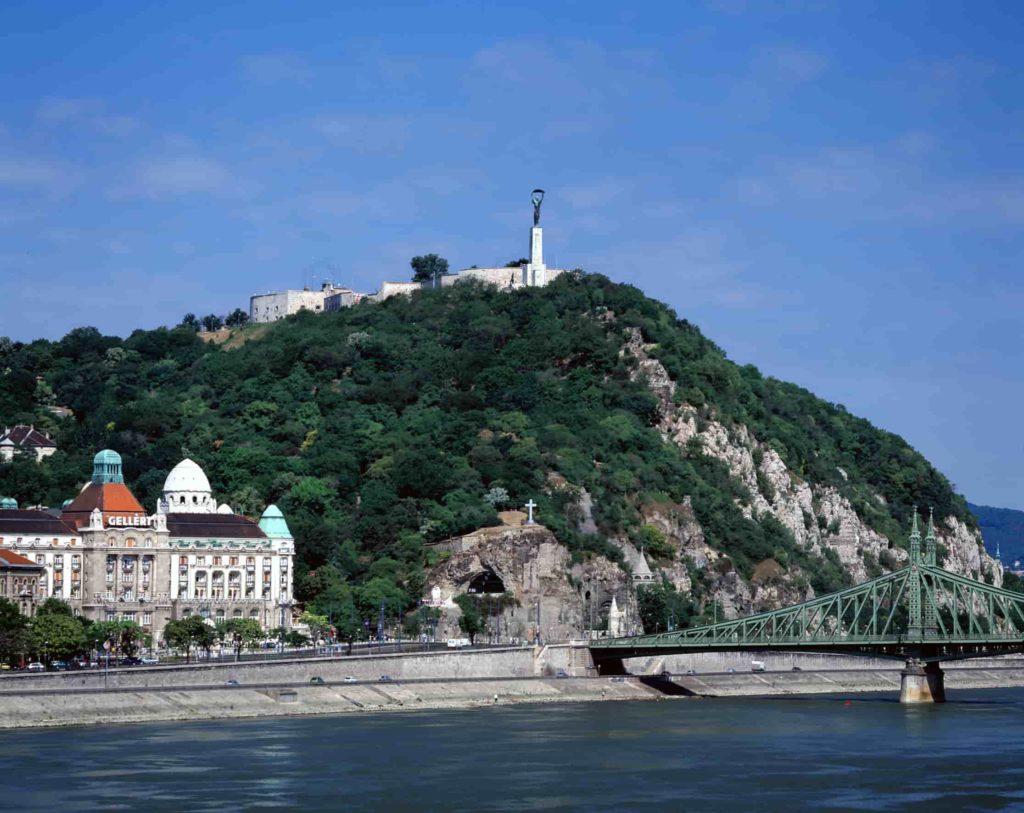Gellért Hill Budapest, the best spot to have a beautiful panorama of the city
 This hill is approximately 300 m high. It is an essential part of the Buda panorama and – since 1987 – also the part of the World Heritage of the UNESCO. Are you interested in cultural sights? Or do you prefer rather the nature? In one way or another, you’ll love the Gellért Hill Budapest! Nowadays only a few untouched areas can be found there but they’re wonderful. The fauna of birds is various, due to the nearness of the River Danube. For example, you can see flycatchers or kinglets – both of them are nice songbirds.
This hill is approximately 300 m high. It is an essential part of the Buda panorama and – since 1987 – also the part of the World Heritage of the UNESCO. Are you interested in cultural sights? Or do you prefer rather the nature? In one way or another, you’ll love the Gellért Hill Budapest! Nowadays only a few untouched areas can be found there but they’re wonderful. The fauna of birds is various, due to the nearness of the River Danube. For example, you can see flycatchers or kinglets – both of them are nice songbirds.
Gellért Hotel & Bath
It can be found at the foot of the hill. This luxurious and glamorous hotel was built in the 19th century and it belonged to the Gellért Baths. Both Hungarian and foreign celebrations visited and enjoyed it very much. From the exclusive guests, we can mention Juliana Dutch Queen who spent her honeymoons there, Nixon American president, Menuhin violinist, or Indian maharajas. The lobby of the Art-Nouveau building isn’t only wonderful but it has extremely good acoustics so it’s also suitable for sound therapy.
A tragic history
In the early middle ages, the hill was called Kelen. Gellért bishop converted several pagan Hungarians to the Christian religion at the time of the foundation of the state. Unfortunately, in 1046, a bloody rebellion broke out against the new, feudal and Christian regime. Although it didn’t last too long, it demanded many victims including Gellért bishop and his monk fellows. He was pushed down from the hill. According to the legend, the River Danube was washing his blood from the stones for seven years… Fortunately, blood cannot be seen nowadays but a great statue (and, of course, the new name of the hill) serves the martyr’s memory.
Follow the witches!
 Have you already seen every important museum, building, and park in the Hungarian capital city? Well, you have probably not heard about the witches of Budapest yet. More exactly, witches of the Gellért Hill Budapest. If you are interested in the topic, visit the Witch Museum which provides interesting information about the belief in witches and the magic overall. If you visit the city during the spring, try to join their exciting tour on the hill during which you can learn about the secrets of the past and the most famous witches in Budapest! There will also be mystic, Celtic celebrations such as New Moon Celebration.
Have you already seen every important museum, building, and park in the Hungarian capital city? Well, you have probably not heard about the witches of Budapest yet. More exactly, witches of the Gellért Hill Budapest. If you are interested in the topic, visit the Witch Museum which provides interesting information about the belief in witches and the magic overall. If you visit the city during the spring, try to join their exciting tour on the hill during which you can learn about the secrets of the past and the most famous witches in Budapest! There will also be mystic, Celtic celebrations such as New Moon Celebration.
Citadella Budapest
The beginning of its history isn’t a nice story. In 1848/49, the Hungarians fought for their freedom against the Habsburg emperor, but they failed the war. The emperor ordered serious punishments; many soldiers were sentenced to death. The Citadelle was built at that time and its 16 m high and 220 m wide walls became the emblem of the oppression for nearly 20 years. Nowadays, tourists gladly visit the building where they can also see an exhibition about the 2nd world war. Moreover, a hotel and a restaurant welcome them, and here can be enjoyed the best view of the city. If the weather is good, the Buda Castle, Margaret Island and Széchenyi Chain Bridge and the House of the Parliament are all visible.
The Liberty Statue Budapest
 It’s probably one of the best-known statues in the city. The original aim of Zsigmond Kisfaludi-Stróbl’s masterpiece was to say thanks to the Soviet soldiers who ‘liberated’ the Hungarian nation from Nazi oppression. As the Soviet army and the Communist regime caused also much suffer, after the fall of Communism the monument wanted to be destroyed. However, the main character which is a nice and peaceful woman holding a palm branch in her elevated hands became really popular among citizens.
It’s probably one of the best-known statues in the city. The original aim of Zsigmond Kisfaludi-Stróbl’s masterpiece was to say thanks to the Soviet soldiers who ‘liberated’ the Hungarian nation from Nazi oppression. As the Soviet army and the Communist regime caused also much suffer, after the fall of Communism the monument wanted to be destroyed. However, the main character which is a nice and peaceful woman holding a palm branch in her elevated hands became really popular among citizens.
So it could stay, but other characters of the monument (including a Soviet soldier) were transported to the Statue Park. Symbols of the Communism were removed and the statue received a new inscription: “As a memorial of those all who devoted their lives for the independence, freedom, and prosperity of Hungary”. An interesting fact signs the popularity of the statue: the first Hungarian spaceman, Bertalan Farkas brought a little copy of it into space in 1980. According to the urban legend, the common nickname of the monument is ’bottle-opener’.
![]()
![]()
![]()

 Skip the Line – Parliament Panorama Cruise
Skip the Line – Parliament Panorama Cruise Drink & Piano Show
Drink & Piano Show Unlimited Booze Cruise Downtown Budapest
Unlimited Booze Cruise Downtown Budapest This hill is approximately 300 m high. It is an essential part of the Buda panorama and – since 1987 – also the part of the World Heritage of the UNESCO. Are you interested in cultural sights? Or do you prefer rather the nature? In one way or another, you’ll love the Gellért Hill Budapest! Nowadays only a few untouched areas can be found there but they’re wonderful. The fauna of birds is various, due to the nearness of the River Danube. For example, you can see flycatchers or kinglets – both of them are nice songbirds.
This hill is approximately 300 m high. It is an essential part of the Buda panorama and – since 1987 – also the part of the World Heritage of the UNESCO. Are you interested in cultural sights? Or do you prefer rather the nature? In one way or another, you’ll love the Gellért Hill Budapest! Nowadays only a few untouched areas can be found there but they’re wonderful. The fauna of birds is various, due to the nearness of the River Danube. For example, you can see flycatchers or kinglets – both of them are nice songbirds. Have you already seen every important museum, building, and park in the Hungarian capital city? Well, you have probably not heard about the witches of Budapest yet. More exactly, witches of the Gellért Hill Budapest. If you are interested in the topic, visit the Witch Museum which provides interesting information about the belief in witches and the magic overall. If you visit the city during the spring, try to join their exciting tour on the hill during which you can learn about the secrets of the past and the most famous witches in Budapest! There will also be mystic, Celtic celebrations such as New Moon Celebration.
Have you already seen every important museum, building, and park in the Hungarian capital city? Well, you have probably not heard about the witches of Budapest yet. More exactly, witches of the Gellért Hill Budapest. If you are interested in the topic, visit the Witch Museum which provides interesting information about the belief in witches and the magic overall. If you visit the city during the spring, try to join their exciting tour on the hill during which you can learn about the secrets of the past and the most famous witches in Budapest! There will also be mystic, Celtic celebrations such as New Moon Celebration. It’s probably one of the best-known statues in the city. The original aim of Zsigmond Kisfaludi-Stróbl’s masterpiece was to say thanks to the Soviet soldiers who ‘liberated’ the Hungarian nation from Nazi oppression. As the Soviet army and the Communist regime caused also much suffer, after the fall of Communism the monument wanted to be destroyed. However, the main character which is a nice and peaceful woman holding a palm branch in her elevated hands became really popular among citizens.
It’s probably one of the best-known statues in the city. The original aim of Zsigmond Kisfaludi-Stróbl’s masterpiece was to say thanks to the Soviet soldiers who ‘liberated’ the Hungarian nation from Nazi oppression. As the Soviet army and the Communist regime caused also much suffer, after the fall of Communism the monument wanted to be destroyed. However, the main character which is a nice and peaceful woman holding a palm branch in her elevated hands became really popular among citizens.



